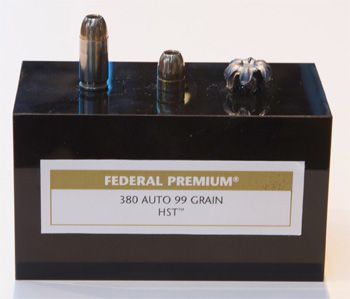I’m a hardcore gun enthusiast, with a strong affinity for the handgun. Fortunately, there’s no shortage of fascinating handguns at SHOT Show.
When you’re surrounded by so many cool and varied designs, it’s easy to forget that the handgun is simply a launch platform. We often obsess over the nuances of various handgun models, but it’s the ammunition we stuff in them that does the real work. As such, it’s worthy of equal, or perhaps even greater scrutiny than the handgun itself.
So, let’s take a quick look at two interesting new products from ammunition giant ATK, the parent company of Federal Premium and Speer Ammo, among other brands.
Speer Gold Dot G2
The Gold Dot line of ammunition is an LE standard, and is recognized for its excellent performance, particularly after passing through tough intermediate barriers like auto glass. For 2015, Speer is expanding the Gold Dot family to include the G2 product line, which incorporates an entirely new bullet design that has been optimized to excel in the latest iteration of the industry-standard, FBI Protocol.
The G2 bullet starts life the same way as the traditional Gold Dot bullet, as a lead core with an electrochemically-bonded copper jacket. A star-shaped punch is used to stab the bullet’s nose and cut all the way through the jacket, forming stress risers. At the base of these cuts is a circular ring around the outside of the jacket that Speer engineers call the “hinge,” whose purpose is to limit the amount of expansion as the petals of the bullet open up.
Interestingly, when the bullet is run through the final shaping dies, there is only a shallow dish of a cavity left in the nose. This dish is filled with liquid elastomer, which hardens as it cures. Upon bullet impact, this plug forces the bullet to open up along its star-shaped fissures and initiate the expansion that is limited by the hinge.
Since expansion is mechanically driven, and not hydrostatically driven (as it is on the standard Gold Dot), the G2 bullet performs more consistently after penetrating barriers, which can plug or deform open cavity designs and alter penetration depth.
In fact, Speer engineers tell me that penetration consistently reaches the 14 to 16 inch optimum range of the new FBI standards. This exceeds the typical 12 to 14 inch penetration achieved by the older Gold Dot, which was engineered to meet an earlier specification that could sometimes encourage shallower penetration.
The new G2 bullet will be loaded into nickel cases using low flash powders, and will initially be offered as a 147 grain 9mm, a 180 grain .40 S&W, and a 230 grain .45 ACP +P.
Federal HST .380 ACP
Like the Gold Dot, the Federal HST is another LE favorite that has developed an exceptional track record. The HST is known for radical expansion, often several times the diameter of the caliber, leaving a projectile that frequently looks more like a starfish than a mushroom.
 |
| The .380 ACP HST bullet is heavy for caliber, at 99 grains. (PoliceOne Image) |
This exceptional round has always been limited to duty calibers (9mm .40 S&W, .357 Sig, and .45 ACP), however, and there has been no provision for the increasingly popular .380 ACP pistols being carried as backups or off-duty weapons. Federal has fixed that for 2015, and it looks like it was worth the wait.
The .380 ACP HST bullet is heavy for caliber, at 99 grains. This extra weight, coupled with surprisingly high velocities of around 930 fps from the stubby, 2.75 inch barrel of the Ruger LCP, allow the bullet to reach around 10 inches of expansion in the Bare Gelatin and Heavy Clothing stages of the FBI protocol.
Getting this kind of performance while staying within SAAMI pressure limits has required a great deal of work and very careful powder selection, but the results appear to be worth the effort.








